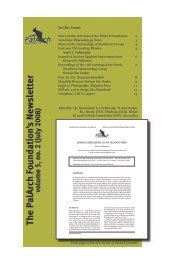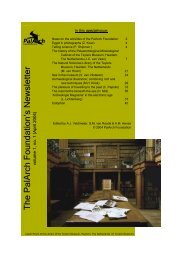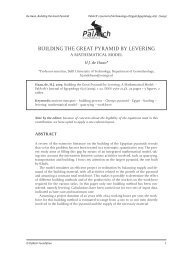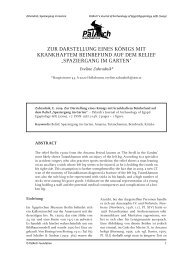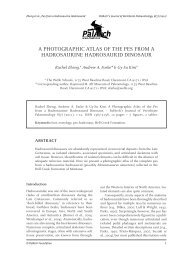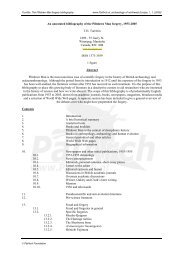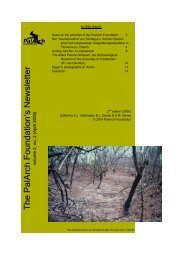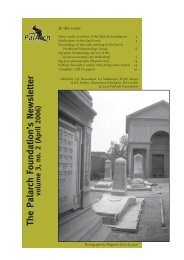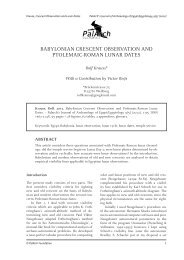neural spine bifurcation in sauropod dinosaurs of the - PalArch
neural spine bifurcation in sauropod dinosaurs of the - PalArch
neural spine bifurcation in sauropod dinosaurs of the - PalArch
Create successful ePaper yourself
Turn your PDF publications into a flip-book with our unique Google optimized e-Paper software.
Wedel & Taylor, Neural Sp<strong>in</strong>e Bifurcation <strong>in</strong> Sauropods <strong>PalArch</strong>’s Journal <strong>of</strong> Vertebrate Palaeontology, 10(1) (2013)<br />
Figure 25. Neurocentral fusion <strong>in</strong> Haplocanthosaurus.<br />
A, B. Posterior cervical vertebra C?12 <strong>of</strong> sub-adult H.<br />
utterbacki holotype CM 879: A, X-ray <strong>in</strong> right lateral<br />
view; B, transverse CT slice show<strong>in</strong>g separate ossificaton<br />
<strong>of</strong> centrum and <strong>neural</strong> arch. C, D. Mid-dorsal vertebra D6<br />
<strong>of</strong> adult H. priscus holotype CM 572: X-rays <strong>in</strong> (C) right<br />
lateral and (D) posterior view, show<strong>in</strong>g fully fused <strong>neural</strong><br />
arch. Modified from Wedel (2009: figure 6).<br />
recognized diplodocid taxon”. In studies <strong>of</strong><br />
evolution, <strong>the</strong> word ‘parsimony’ has a specific<br />
mean<strong>in</strong>g: it refers to m<strong>in</strong>imis<strong>in</strong>g <strong>the</strong> number<br />
<strong>of</strong> character-state changes.<br />
We evaluated <strong>the</strong> parsimony <strong>of</strong> <strong>the</strong> hypo<strong>the</strong>sis<br />
that Suuwassea or Haplocanthosaurus –<br />
also mentioned by Woodruff & Fowler (2012: 9)<br />
as a candidate for synonymy – was <strong>the</strong> juvenile<br />
form <strong>of</strong> one <strong>of</strong> <strong>the</strong> previously known diplodocids.<br />
For <strong>the</strong> purpose <strong>of</strong> this analysis we<br />
ignored <strong>the</strong> evidence that both <strong>the</strong>se genera<br />
are known from adult <strong>in</strong>dividuals, and considered<br />
how many additional steps would be<br />
needed to make <strong>the</strong>m <strong>the</strong> sister taxa <strong>of</strong> one <strong>of</strong><br />
<strong>the</strong> diplodocids, or some o<strong>the</strong>r Morrison Formation<br />
<strong>sauropod</strong>. The method was as follows :<br />
• Beg<strong>in</strong> with <strong>the</strong> character-taxon matrix from<br />
a previously published peer-reviewed phylogenetic<br />
analysis;<br />
• Re-run <strong>the</strong> matrix to verify that <strong>the</strong> results<br />
are <strong>the</strong> same as <strong>in</strong> <strong>the</strong> published paper based<br />
on it. This step re-establishes <strong>the</strong> null hypo<strong>the</strong>sis<br />
and demonstrates that <strong>the</strong> matrix is<br />
be<strong>in</strong>g run correctly.<br />
• For each candidate synonymy, impose a constra<strong>in</strong>t<br />
that <strong>the</strong> synonymous taxa are <strong>in</strong> a<br />
sister-group relationship – for example, that<br />
Suuwassea and Apatosaurus are more closely<br />
related to each o<strong>the</strong>r than to any o<strong>the</strong>r<br />
OTU. Note that <strong>the</strong> characters, taxa and cod<strong>in</strong>gs<br />
are not modified;<br />
• Run <strong>the</strong> matrix aga<strong>in</strong>, with <strong>the</strong> constra<strong>in</strong>t<br />
<strong>in</strong> place, and note <strong>the</strong> length <strong>of</strong> <strong>the</strong> most<br />
parsimonious trees. The difference between<br />
this and <strong>the</strong> orig<strong>in</strong>al tree-length is a<br />
measure <strong>of</strong> how unparsimonious <strong>the</strong> proposed<br />
synonymy is;<br />
• Repeat as needed with o<strong>the</strong>r constra<strong>in</strong>ts to<br />
evaluate o<strong>the</strong>r phylogenetic hypo<strong>the</strong>ses.<br />
We performed this exercise twice: first<br />
with <strong>the</strong> matrix <strong>of</strong> Taylor (2009), as <strong>the</strong> only<br />
available study that treated <strong>the</strong> Morrison<br />
Formation brachiosaurid Brachiosaurus as a<br />
dist<strong>in</strong>ct taxon; and second with that <strong>of</strong> Whitlock<br />
(2011), which was focussed particularly<br />
on <strong>the</strong> <strong>sauropod</strong> subclade Diplodocoidea. The<br />
results are given <strong>in</strong> table 2.<br />
In <strong>the</strong> analysis <strong>of</strong> Taylor (2009), Suuwassea<br />
is separated from Apatosaurus by only two<br />
steps (and by eight or more steps from <strong>the</strong><br />
o<strong>the</strong>r taxa). However, <strong>the</strong> separation between<br />
<strong>the</strong>se two taxa leaps to 21 steps <strong>in</strong> Whitlock’s<br />
(2011) analysis. Suuwassea’s separation from<br />
<strong>the</strong> o<strong>the</strong>r dipldococids is similarly <strong>in</strong>creased<br />
<strong>in</strong> Whitlock’s analysis, because this conta<strong>in</strong>s<br />
more characters that are parsimony-<strong>in</strong>formative<br />
with<strong>in</strong> Diplodocoidea. The more closely<br />
we look at Suuwassea, <strong>the</strong> less closely it resembles<br />
diplodocids.<br />
In <strong>the</strong> case <strong>of</strong> Haplocanthosaurus, <strong>the</strong> numbers<br />
<strong>of</strong> additional steps required are much<br />
more similar between <strong>the</strong> two analyses. In<br />
both analyses, it is very widely separated from<br />
<strong>the</strong> diplodocids (from 24–37 steps), but much<br />
less separated from <strong>the</strong> basal macronarian Camarasaurus.<br />
Taylor (2009) recovered Haplocanthosaurus<br />
as just outside Neo<strong>sauropod</strong>a, so<br />
equally distant from Diplodocoidea and Macronaria,<br />
whereas Whitlock (2011) recovered it<br />
as <strong>the</strong> most basal diplodocoid. The large number<br />
<strong>of</strong> steps required to move it fur<strong>the</strong>r down<br />
<strong>in</strong>side Diplodocoidea <strong>in</strong> Whitlock’s analysis<br />
are partly due to that study’s focus on characters<br />
that are <strong>in</strong>formative with<strong>in</strong> Dipodocoidea,<br />
but also reflects how close to <strong>the</strong> base <strong>of</strong><br />
Neo<strong>sauropod</strong>a both Haplocanthosaurus and<br />
Camarasaurus are.<br />
The nexus files used <strong>in</strong> this analysis are<br />
available as supplementary <strong>in</strong>formation: doi:<br />
© <strong>PalArch</strong> Foundation 28



